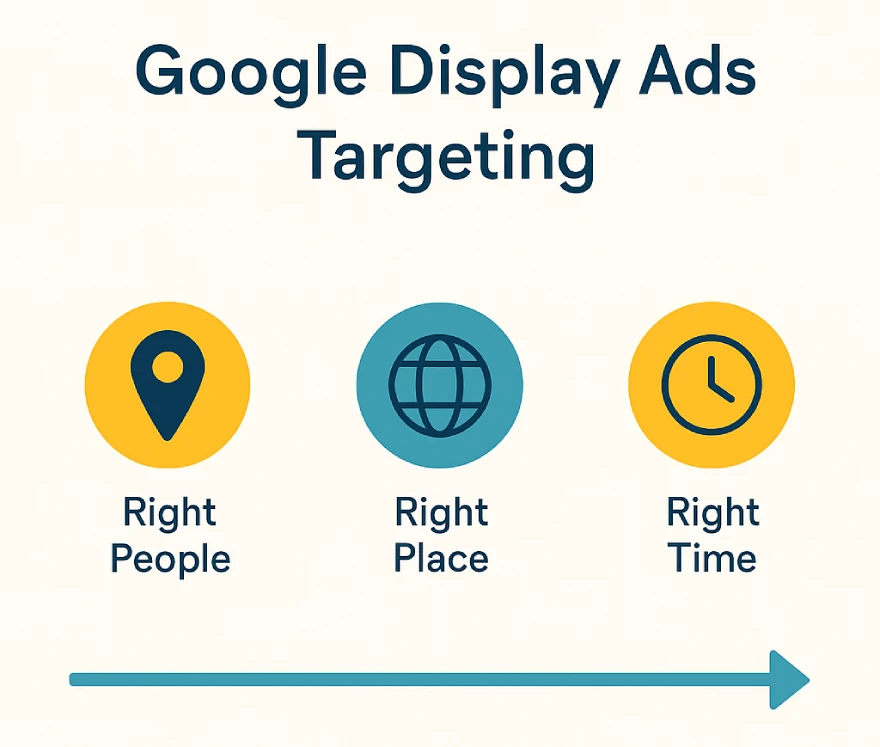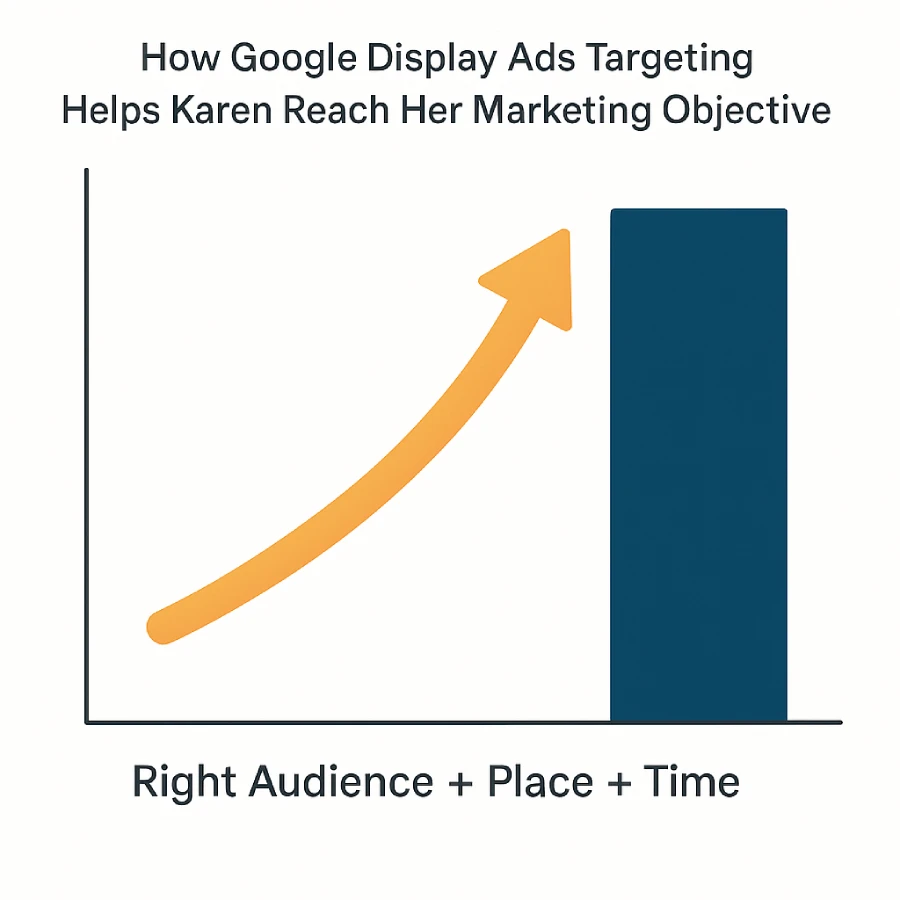I was helping a friend recently who just started a new business, and she asked me,
“How can I make sure my ads actually reach the right people so they notice my products?”
It made me think about how powerful Google Display Ads targeting really is. It’s not just about showing ads anywhere, it’s about showing them to the right audience, in the right places, at just the right time.
In this post, we’ll explore exactly how Google Display Ads targeting helps new businesses like Karen’s build awareness and connect with potential customers efficiently.
Question
Karen has opened a new business and is using Google Display Ads to build awareness of her new products. How does Google Display Ads targeting help Karen reach her marketing objective?
- By tracking website traffic, improving customer service, and driving longer customer interactions.
- By getting her ad in front of the right people, in the right place, at the right time.
- By building a social following, improving customer engagement, and driving larger transactions.
- By getting her ad to the people she selects, based on automated marketing objective tracking.
Here is the correct answer
✅ B) By getting her ad in front of the right people, in the right place, at the right time.

Why is this correct?
1. Reaching the Right People
Google Display Ads offer powerful targeting options like demographics, interests (Affinity Audiences), in-market segments, and remarketing, which help show ads to people likely to be interested in Karen’s products.
2. Appearing in the Right Places
Ads appear on millions of websites, apps, YouTube, and Gmail where Karen’s potential customers spend their time, maximizing visibility.
3. Timing Matters
Google’s automated systems optimize when and where ads appear, increasing the chance of reaching customers when they’re most receptive.
Together, this targeting ensures Karen’s ads don’t get lost in the noise—they reach the right eyes at the right moment, perfect for building product awareness.
Why are other options incorrect?
A) Tracking website traffic, improving customer service, and driving longer interactions
- These are valuable business goals, but not direct outcomes of Google Display Ads targeting. Display Ads focus on awareness and reach rather than customer service.
C) Building social following, improving engagement, and driving larger transactions
- These outcomes relate more to social media marketing or conversion-focused campaigns, not primarily Display Ads awareness campaigns.
D) Getting ads to people she selects based on automated marketing objective tracking
- Google Display Ads use automated targeting, but not solely based on selections from the advertiser; it combines machine learning with targeting options, and it’s not just “people she selects.”
Real-Life Example: Karen’s Handmade Jewelry Brand

Karen used Google Display Ads to reach women aged 25–40 interested in fashion and accessories. By leveraging Affinity Audiences and contextual targeting, her ads appeared on popular lifestyle blogs and YouTube channels.
Within two months:
- Website visits increased 60%
- Social media followers grew organically
- Local store foot traffic improved
Her targeted display campaign helped build awareness efficiently, showing ads to the right customers at the right time.
How Google Display Ads Targeting Works
| Targeting Aspect | How It Helps Karen |
|---|---|
| Audience Targeting | Shows ads to people interested in her products |
| Placement Targeting | Ads appear on relevant websites and apps |
| Timing Optimization | Ads show when users are most receptive |
| Automated Optimization | Google adjusts targeting to improve performance |
Helpful Resources
- Google Ads Help: Display Campaign Targeting
- Think with Google: Display Ads Effectiveness
- Google Skillshop: Display Ads Certification
- YouTube: Google Display Ads Tutorial
- WordStream: Display Ads Targeting Strategies
Conclusion
Google Display Ads targeting helps Karen build product awareness by getting her ads in front of the right audience, on the right platforms, and at the most effective times.
This precision targeting ensures her new business’s message reaches potential customers efficiently, laying the foundation for long-term success.
Now, if you are ready, you can take the Google Skillshop test for the Google Ads Display Exam. Want more real exam questions with easy answers like this? Follow along — I’ll be breaking down more Google Ads Display Measurement Certification Free examples in the next posts!
FAQs
1. What targeting options does Google Display Ads offer?
Google Display Ads let you target based on demographics (age, gender), interests (Affinity Audiences), purchase intent (In-market Audiences), topics, placements (specific websites/apps), and remarketing (people who’ve visited your site before).
2. Can I target people based on their interests?
Yes! Affinity Audiences help you reach users who have demonstrated long-term interests, while In-market Audiences focus on people actively researching or planning to buy products like yours.
3. Do Google Display Ads only appear on websites?
No, they also appear on YouTube, Gmail, mobile apps, and across millions of partner sites through the Google Display Network.
4. How does Google decide when to show my ads?
Google uses machine learning to analyze when users are most likely to engage and converts, optimizing ad delivery times automatically.
5. Are Google Display Ads effective for brand awareness?
Absolutely! Display Ads are designed to put your brand in front of relevant users early in the buying journey, increasing recognition and interest.
6. Can I exclude certain websites or types of content from showing my ads?
Yes, you can exclude placements and content categories that don’t align with your brand values or campaign goals.
7. Are Google Display Ads expensive?
You control your budget and bidding strategy, so Display Ads can be very cost-effective for small businesses.
8. How can I measure the success of my Display Ads campaign?
Track metrics like impressions, click-through rates, conversions, and engagement to see how well your ads are performing.
9. What’s the difference between Display Ads and Search Ads?
Display Ads appear visually on websites, apps, and videos, while Search Ads are text ads triggered by keywords on Google’s search results pages.
10. Can I use images and videos in my Display Ads?
Yes! Google Display Ads support images, videos, and responsive ad formats to engage your audience more effectively.
